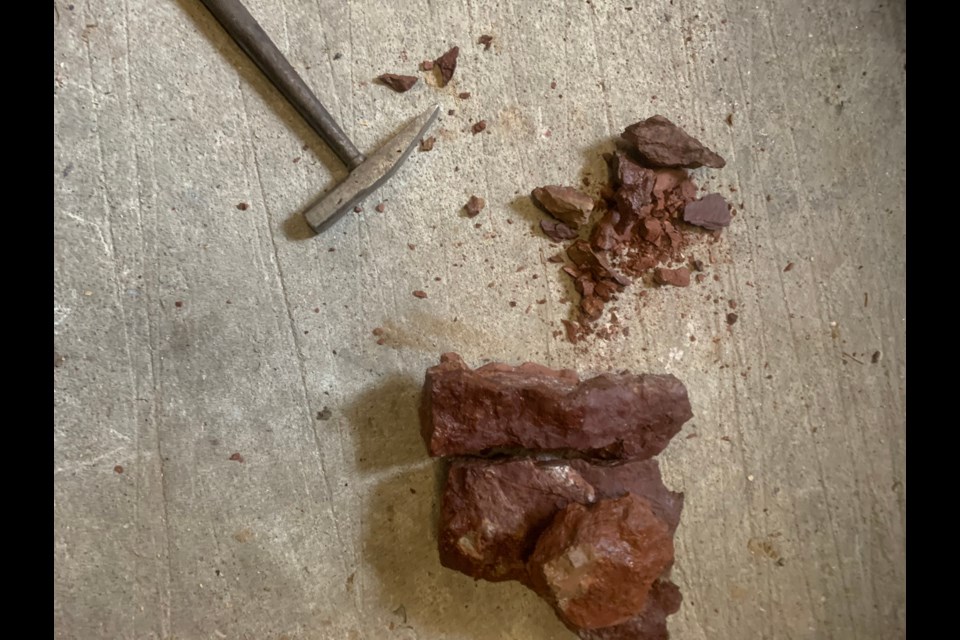With time on our hands, there have been countless COVID-19 stories related to unique human behaviour. In times of stress it can be more difficult than ever to smile awhile.
But what do tiny baby hands and feet have to do with an ochre mine? Ochre was utilized as the organic medium for indigenous rock face paintings called pictographs. These stone canvases are found throughout the northeast at more than 80 sites including the well-known collections at Agawa, north of Sault Ste. Marie, Fairy Point, west of Chapleau and Wizard Lake near Gogama. There are few countries in the world that do not have evidence of rock paintings, an anthropological record of early aboriginal inhabitants.
The “paint” is made of ochre and there are two significant sources within northeastern Ontario.
Every parent stares at their new baby in amazement and wonders how they could possibly be so tiny, and before too long, that baby has grown and it is hard to remember just how tiny they really were. Feet and hands casting remains popular and there are many techniques from digital to molding/painting powder kits starting at $17.95 with accessories.
But one couple during this trying time had a different notion. Imagine your child being born at the height of the pandemic. That is part of Finley David McGirr’s storyline: he was born April 11 in North Bay and the parents are Kim and Jeff McGirr who live near Bonfield.
The couple purchased a baby timeline book wanting to record significant information and milestones.
“A must do is always the hands and feet prints," said Jeff.
They had researched that you could purchase ink kits that were non-toxic or finger paint but decided that they would make something from nature.
“I had handpicked blueberries purchased last August in Matheson, at a road side stand however these were much better suited for a delicious pie.”
“We both spend most of our free time outdoors in Northern Ontario, there's really no place we'd rather be and want Finley to share our connection with the outdoors, and we’re not naturalists by any means," said Jeff.
Jeff’s vocation is linked to the marketing of motorized recreation products and his avocation is related to the creation of print and digital media related to the same.
“Motorsports is my thing, in particular snowmobiling, off-roading and boating but we do enjoy camping, kayaking and hiking all the same — we love it all. The prints with ochre are symbolic, it’s how we want to raise our boy, and we embrace the go-ahead, get-dirty-outside, in the wilderness!“
They settled on a very natural substance, an earthy pigment, its reddish colour from the mineral hematite, which is a crystalline iron oxide.
“Ochre's the original all-natural paint, it’s been used for millennia. I've been by river mine below Parresseux Falls many times however I'd never brought any ochre back and this is where Bill came in.”
The cave is one of two sites in northeastern Ontario and ochre was a prized trade item during the Amerindian trading network prior to the arrival of the colonials. Back Roads Bill was contacted for a rock sample and the exchange was made through a GPS treasure hunt for Jeff, the clues leading him to a nearby cemetery.
“Bill wanted to avoid any proximity exchange and to make sure my navigation skills stayed sharp, and there it was: the chunk of ochre located behind a headstone, the family name being one of the clues.”
Jeff describes how he turned the ochre into something he could use as paint:
"The process in creating a tempera was not easy. You really need to pulverize the rock to get it into a powder form suitable to "paint" with.
The piece was approximately 1.3 kilograms and 10 centimetres by 10 centimetres square. I first broke off a section, then broke that section into smaller chunks. I then used an old stainless camping pot and transferred my small chunks of ochre over and began pounding away with a steel hammer. It takes patience as you have to keep all of your ochre a similar size to end up with a fine powder. After about one hour I had a fine powder of even consistency and mixed with a bit of water formed an excellent ink."
Jeff said, “For your information, trying to get a 'perfect' print of newborn baby tiny hands and feet is essentially impossible.”
As a parent, you want to remember how precious and tiny your child once was. Finley will look back with his parents, and the COVID-19 time will be more than a memento. Here are the two locations of the ochre mines on the Mattawa River and Lake Superior, along with the three pictograph sites referenced:
